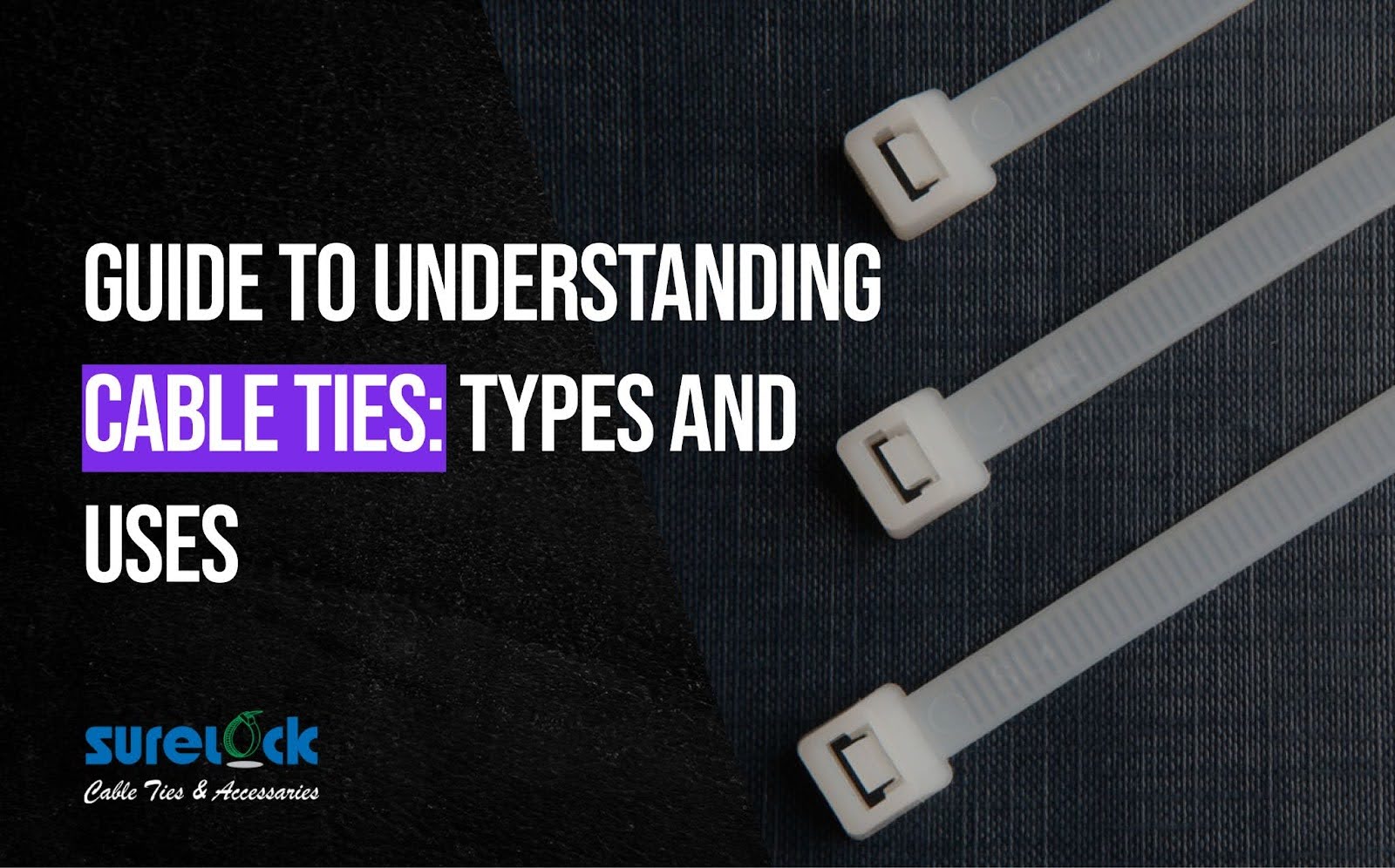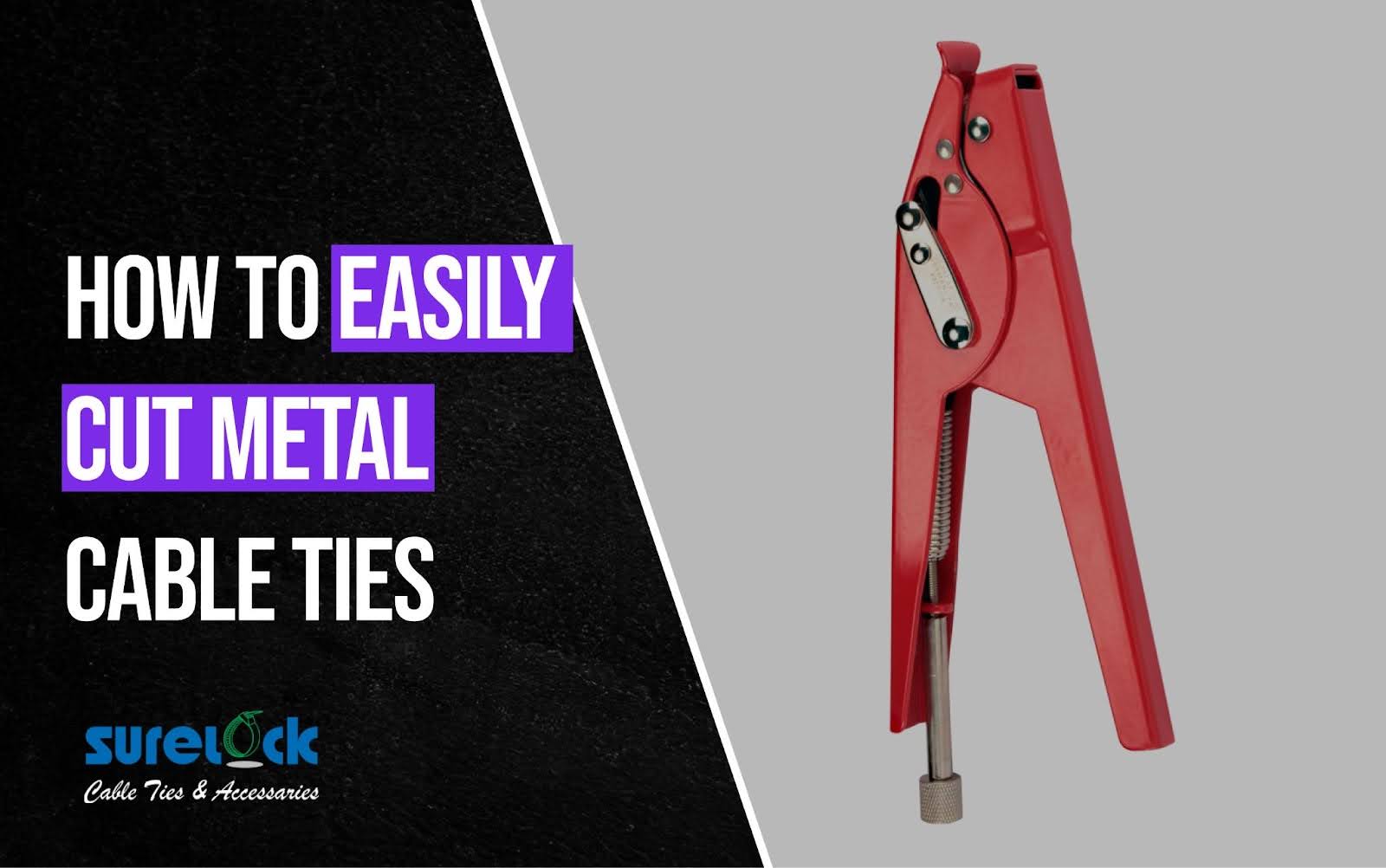How to Use and Tighten Stainless Steel Cable Ties
October 7, 2025

Stainless steel cable ties offer unmatched durability, but only if you know how to use them correctly. Whether bundling wires in automotive assembly or securing telecom equipment outdoors, proper installation ensures reliable and long-lasting performance.
Industries like construction, automotive, and telecommunications are seeing growing demand for strong and reliable fastening solutions. The global market for stainless steel cable ties is projected to reach USD 1.1 billion by 2031, growing at a CAGR of 5.4 percent, highlighting the need for high-performance cable management in demanding environments.
Poor installation practices, such as incorrect tensioning, using inappropriate tools, or choosing the wrong stainless steel grade, can lead to cable abrasion, slippage, corrosion, and system downtime.
In this blog, we will show you how to use stainless steel cable ties effectively. Surelock offers a range of high-quality cable ties for industrial applications.
Quick Insights for Using Stainless Steel Cable Ties
- Proper grade selection is crucial: 316 for marine or chemical exposure, 304 for general industrial use, and 201 for light-duty applications.
- Coated and uncoated ties have different tension requirements—over-tightening coated ties can damage the protective layer.
- Using the right tools, like tensioners and cable cutters, ensures consistent fastening and prevents cable damage or slippage.
- Releasable, ball-lock, and easy-lock ties serve distinct purposes; choosing the correct type improves safety, efficiency, and long-term performance.
- Regular inspection and correct installation prevent tie failure, maintain cable integrity, and extend system reliability in demanding environments.
What is a Stainless Steel Cable Tie?
A stainless steel cable tie is a strong and durable fastening device that bundles, secures, and organizes cables, wires, hoses, and other materials. Stainless steel cable ties, when used correctly, can secure cables in extreme environments without failure, making them ideal for demanding industrial applications where standard nylon ties may not perform.
These ties are manufactured in different grades to suit various environments:
- 316 Stainless Steel: Marine-grade, highly resistant to corrosion; ideal for offshore, marine, or chemical-exposed environments.
- 304 Stainless Steel: General-purpose with good durability; suitable for indoor and outdoor industrial use.
- 201 Stainless Steel: Cost-effective, light-duty option with lower corrosion resistance; suitable for non-critical applications.
Industries Served: Automotive, aerospace, telecommunications, construction, and other sectors requiring robust cable management.
To help you quickly compare the grades, environments, and key features, see the table below:
Stainless steel cable ties are available in various types, each designed for specific applications and environments.
Why Use Stainless Steel Cable Ties?
Stainless steel cable ties are essential for secure, durable, and efficient cable management across industries. Choosing the right cable tie ensures safety, reliability, and long-term performance in demanding environments.
Key Benefits of Using Stainless Steel Cable Ties:
- Durability and Strength: Stainless steel ties withstand extreme temperatures, UV exposure, chemicals, and mechanical stress, making them ideal for harsh industrial environments.
- Corrosion Resistance: Coated and high-grade stainless steel ties resist rust and corrosion, ensuring long-lasting performance even in outdoor or marine conditions.
- Secure Fastening: The locking mechanism provides a firm hold, reducing slippage, abrasion, and the risk of system downtime.
- Versatility: Suitable for a wide range of applications, including automotive, telecommunications, construction, oil and gas, and food processing.
- Cost-Effectiveness: By preventing damage to cables and equipment, stainless steel ties reduce maintenance costs and operational interruptions.
Understanding these benefits helps highlight why selecting the right type of stainless steel cable tie is critical. In the next section, we will explore the different types of stainless steel cable ties and their ideal applications.
Types of Stainless Steel Cable Ties
Choosing the right type of stainless steel cable tie is critical to ensure secure installation. Each tie has unique features, ideal industries, and slight differences in installation that can affect performance in demanding environments. To make selection easier, the table below summarizes the main types and their key characteristics:
Notes on installation
- Coated ties may require slightly less tension to avoid damaging the coating.
- Releasable ties allow adjustments while ball-lock and easy-lock ties need full tightening for a secure hold.
Choosing the right type ensures reliability, safety, and long-lasting performance in your cable management system.
Understanding the different types of stainless steel cable ties is the first step. Now let’s look at the tools you’ll need to install them effectively and safely.
Selecting the Right Tools for Stainless Steel Cable Ties
The right tools not only make the job easier but also ensure that the ties stay secure over time, especially in harsh conditions where durability is crucial. They also help achieve consistent results across installations, reducing the risk of human error and enhancing the overall efficiency of the process.
Here are all the tools you’ll need:
1. Cable Tie Tensioning Tools
These tools are specifically designed to apply consistent tension to stainless steel cable ties, ensuring an even, secure fastening. Using a cable tie tensioning tool helps to eliminate the risk of over-tightening or under-tightening, both of which can lead to performance issues or failures. These tools are especially useful in high-volume applications where consistency is key.
2. Wrenches and Pliers
Wrenches and pliers are versatile tools that play a role in tightening and adjusting stainless steel cable ties. While pliers help in gripping and securing the tie, wrenches are essential for making final adjustments, especially when dealing with larger cable tie sizes or those used in heavy-duty applications.
3. Cable Cutters
High-quality cable cutters are essential for trimming the excess length of the stainless steel cable tie once it is tightened. Using specialized cutters for stainless steel ensures a clean cut without causing damage to the tie or the material being fastened. It also prevents fraying, which could impact the overall performance of the tie.
Once you've selected the right tools for tightening stainless steel cable ties, you should focus on properly using them for optimal performance.
How to Use Stainless Steel Cable Ties?
Before tightening the stainless steel cable ties, they must be positioned correctly around the cables or secured items. Improper positioning can cause uneven tension and lead to a weak hold. Here’s what you can do:
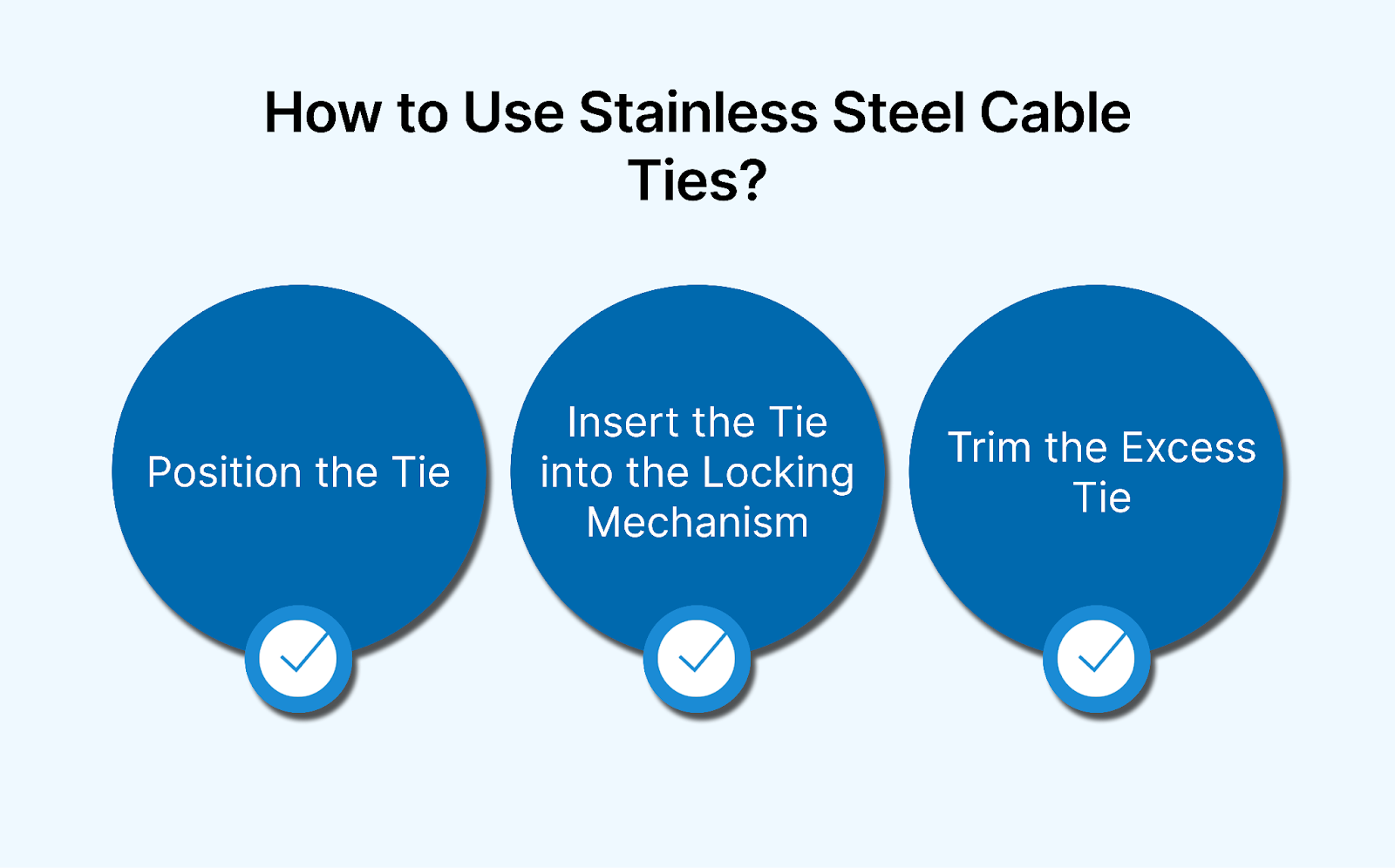
Step 1: Position the Tie
Place the cable tie around the bundle of cables, wires, or components. Ensure the tie is positioned securely and the locking mechanism is easily accessible.
Step 2: Insert the Tie into the Locking Mechanism
Feed the free end of the tie through the locking mechanism of the tie’s head. Ensure the teeth of the tie are properly engaged with the locking mechanism to secure the tie.
Step 3: Trim the Excess Tie
Once the tie is tightly secured, use wire cutters or a cable tie tool to trim the excess length of the tie. Leave a small portion to ensure the tie does not come loose.
Once the tie is positioned and securely inserted, it's essential to tighten it properly to ensure a firm hold.
How to Tighten Stainless Steel Cable Ties Properly?
Proper tensioning of stainless steel cable ties is critical to ensuring both safety and performance in demanding environments. Over-tightening can damage cables, cause insulation failure, or even compromise structural integrity, especially in high-vibration or high-temperature applications. On the other hand, under-tightening may lead to slippage, loose bundling, and long-term reliability issues.
Here’s a step-by-step guide on how to tighten stainless steel cable ties properly:
Step 1: Gather the Necessary Tools
Before beginning the process, ensure that you have the required materials and tools:
- Stainless steel cable ties (choose the right size and type for your application).
- Tensioning tools (either manual or automatic).
- Wrenches and pliers to aid in tightening and adjusting the ties.
Step 2: Position the Cable Tie
Place the stainless steel cable tie around the bundle of cables, wires, or components you wish to secure. Ensure the tie is positioned properly with the locking mechanism easily accessible for tightening. It's crucial to align the tie so that the pressure is evenly distributed.
Step 3: Insert the Tie into the Locking Mechanism
Feed the free end of the cable tie through the locking mechanism of the tie's head. Be sure that the teeth of the tie are properly engaged with the locking mechanism. This ensures the tie will grip securely and not slip out when tightened.
Step 4: Tighten the Cable Tie
Once the cable tie is properly positioned, the next step is to tighten it securely. Depending on the tools you're using, this process can vary slightly. Here’s how to tighten your stainless steel cable tie manually or using an automatic tool.
- Manual Tightening: If you're using a manual tool, pull the tie through the locking mechanism until it is tight enough to hold the bundle securely. Use pliers or a tensioning tool to tighten it further, ensuring it is snug but not over-tightened, as this could damage the tie or the cables.
- Automatic Tightening: If using an automatic tool, position the tie in the tool’s head and begin tightening. Automatic tools apply consistent pressure, ensuring the tie is tightened evenly without excessive force.
Step 5: Achieve the Desired Tension
To ensure that the tie is tightened correctly, you should aim for optimal tension that holds the cables securely without being too tight. Typically, a tension level that prevents a 4-inch object from passing through between the cables is sufficient. If the tie is too tight, it could damage the cables; if it’s too loose, the bundle could become unsecured.
Step 6: Fine-Tuning the Tension
Once the tie is tightened, start adjusting the tension from the center of the bundle. Alternate adjustments moving towards the top and bottom to ensure the tension is evenly distributed throughout. This step helps ensure that the entire bundle is firmly held and that no part of the tie is over-tightened.
Step 7: Trim the Excess Tie
Once the tie is securely tightened, use a cable cutter to trim the excess length of the stainless steel cable tie. Make sure to leave a small portion of the tie for added security. It’s important not to leave any sharp ends exposed that could pose a safety risk or damage surrounding components.
Step 8: Final Checks and Maintenance
After tightening, inspect the tie to ensure it is securely fastened and performing as expected. Check for any signs of excessive tension, which could cause deformation of the tie or damage to the material. Regular maintenance and inspection of the ties are also important, especially in harsh environments, to ensure they remain effective over time.
You can ensure a secure and lasting fastening by following the above steps for tightening stainless steel cable ties. However, it's important to be aware of common mistakes that can impact their performance. With the right technique, these issues can easily be avoided.
Common Mistakes to Avoid When Using Stainless Steel Cable Ties
To get the most out of your stainless steel cable ties, it's important to avoid common mistakes that can affect their performance. These errors can lead to failure and safety risks from improper tensioning to using the wrong tools.
Here's a look at the key mistakes to avoid when using stainless steel cable ties.
- Over-tightening: Tightening the cable tie too much can cause damage to the cables or the tie itself. Always ensure the tie is tight enough to hold the bundle securely but not too tight to cause deformation.
- Incorrect Size Tie: Using a tie that is too small or too large for your application can lead to poor performance. Make sure the cable tie size is appropriate for the bundle.
- Using the Wrong Tool: For high-stress applications, it’s important to use the correct tool to tighten the tie. Avoid using pliers when a cable tie tool or pneumatic tool is needed for consistency.
By avoiding these common mistakes, you can ensure that your stainless steel cable ties perform optimally and securely. Now, let’s explore some important safety considerations to keep in mind when working with these durable fastening solutions.
Safety Considerations When Using Stainless Steel Cable Ties
While stainless steel cable ties are durable and reliable, they require careful handling to ensure safety. Here are some key safety considerations:
- Wear Gloves: Stainless steel cable ties can have sharp edges. Wearing gloves protects your hands from cuts and injuries.
- Use Proper Cutting Tools: When trimming the excess length of the tie, always use the correct cutting tools to avoid injury.
- Dispose of Used Ties Safely: Be cautious when disposing of used ties, particularly those with sharp edges. Ensure they are placed in a safe container to prevent injury.
Following the safety considerations is essential when handling stainless steel cable ties. To further assist you, Surelock offers a comprehensive range of stainless steel cable ties tailored to meet diverse industrial needs.
Surelock's Durable Stainless Steel Cable Ties for Every Application
Surelock is a leading manufacturer and supplier of high-quality cable ties, security seals, and wiring accessories, serving a wide range of industries globally. Their stainless steel cable ties are specifically designed for superior durability, reliability, and performance, making them the ideal solution for the most demanding environments.
Surelock's stainless steel ties are available in various types, including:
- Reusable Steel Ties: Offered in both coated and uncoated versions, Reusable Steel Ties are suitable for corrosive climates and high-temperature environments.

- Ball Lock Steel Ties: These self-locking ties are designed for fast and secure installations, available in coated and uncoated options.

- Easy Lock Steel Ties: Featuring a multiple locking system, Easy Lock Steel Ties ensure strong and secure installations, with both coated and uncoated varieties.

- Multi Lock Steel Ties: Designed for higher tensile strength requirements, Multi Lock Steel Ties are available in coated and uncoated forms.
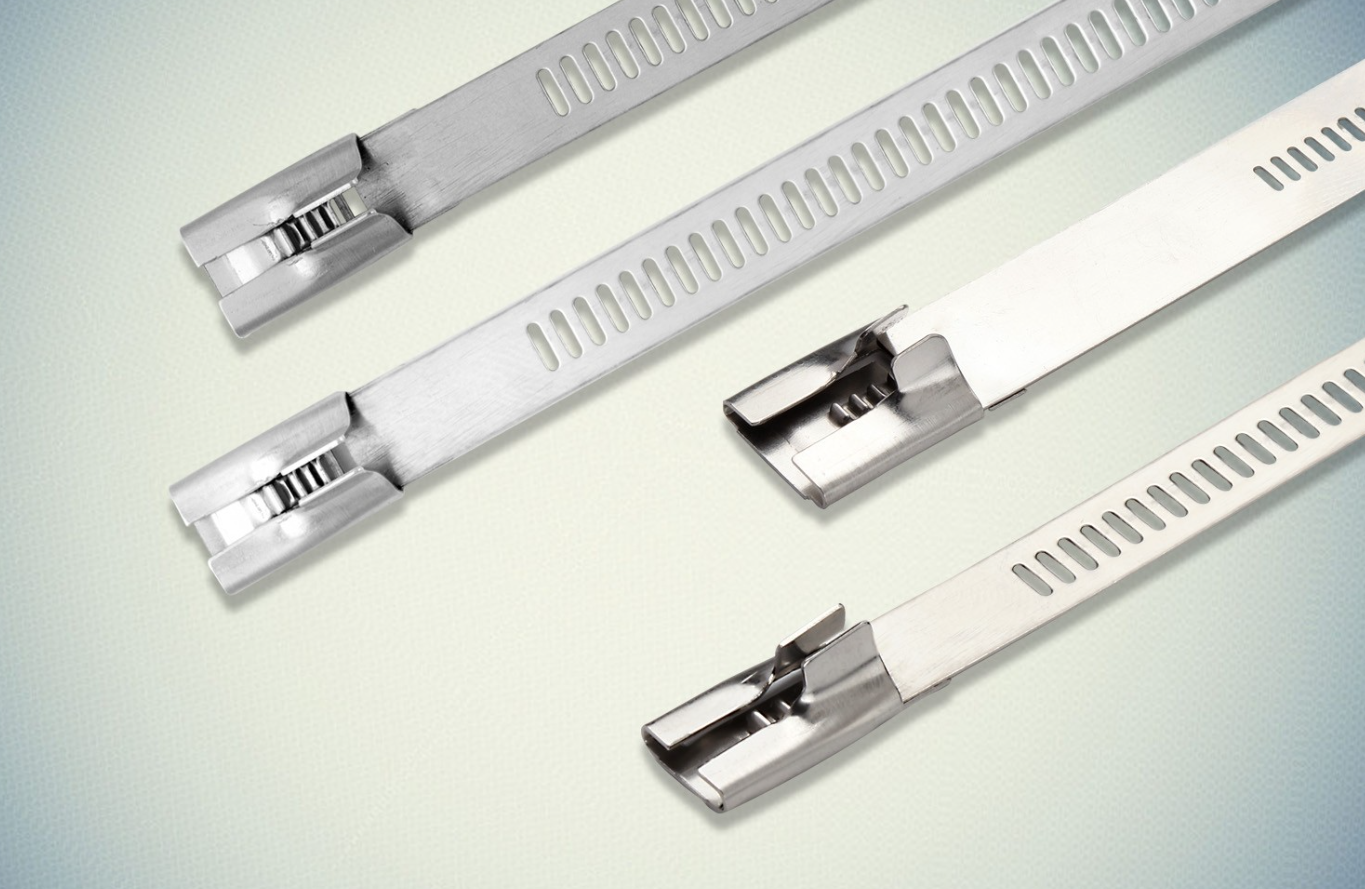
- Reusable Economy Steel Ties: These cost-effective ties are available in coated and uncoated versions, suitable for low-tensile applications.

Tie Tensioning and Cutting Tool
For precise installation and cutting of stainless steel cable ties, Surelock offers a range of high-quality tensioning and cutting tools:
- Tie Tensioning / Cutting Tool – STT 1: This tool is ideal for tensioning and cutting multi-lock, ball-lock, and easy-lock steel ties. It is built to provide secure and accurate installations in various industrial applications, ensuring high efficiency and reliability.

Tie Tensioning / Cutting Tool – STT 2: Designed for tensioning and cutting multi-lock, easy-lock, and ball-lock steel ties, this tool provides enhanced control and efficiency during installation. It features an ergonomic design that reduces user fatigue and ensures consistent, high-quality performance.

- Tie Tensioning Hook – STT 3: Made from lightweight carbon steel, this tool is used with coated and uncoated releasable and ladder stainless steel ties. It’s designed for quick and easy installation and tensioning, making it ideal for applications in the automotive, aerospace, and electrical/electronics industries.
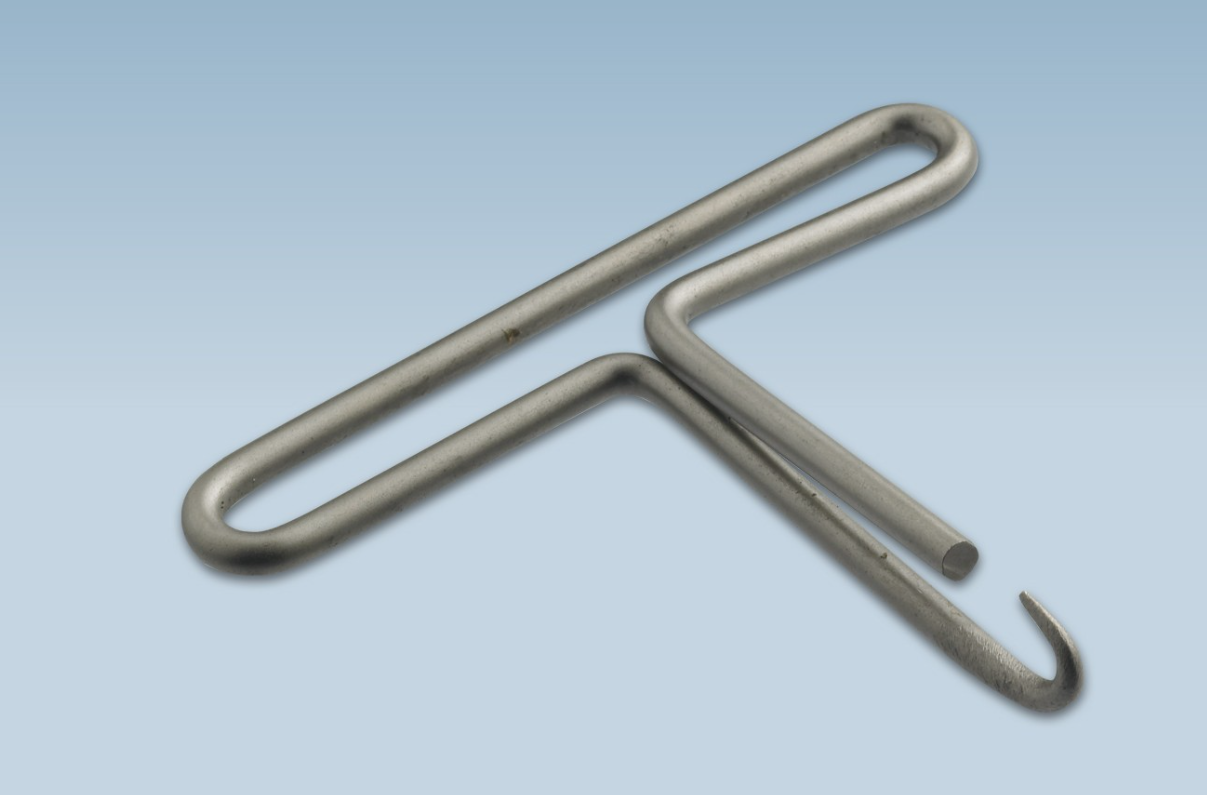
- Tie Tensioning / Cutting Tool – STT 4: Specifically designed for tensioning and securing multi-lock stainless steel cable ties, the STT 4 tool offers precision and reliability. It's ideal for industries such as automotive, aviation, and electrical/electronics, ensuring secure installations in demanding environments.

These tools are engineered to complement Surelock’s stainless steel cable ties, helping to ensure safe and effective installation, enhancing the reliability and durability of your fastening systems.
Conclusion
Understanding how to use stainless steel cable ties correctly ensures that they perform efficiently and securely in various applications. By following the proper installation and tightening procedures, industries can maximize the lifespan and performance of their cable ties, even in harsh conditions.
For high-performance and reliable stainless steel cable ties, Surelock offers a wide range of solutions designed to meet the needs of various industries. Whether you require ties for automotive, marine, or telecommunications applications, Surelock has the right product to secure your components reliably.
Ready to secure your components with reliable, high-performance solutions? Explore Surelock’s range of stainless steel cable ties and learn how to use and tighten stainless steel cable ties for optimal results in your industry.
FAQs
1. How do I choose the right size of stainless steel cable tie for my application?
The correct size depends on the diameter and weight of the cable bundle or object being secured. Users should measure the circumference of the bundle and select a cable tie with enough length to wrap around it and overlap for locking. Thicker or wider ties provide higher tensile strength, making them suitable for heavy-duty industrial applications.
2. Can stainless steel cable ties be reused after installation?
Most stainless steel cable ties are designed for single use, especially those with ball-lock or easy-lock mechanisms. However, releasable types are available and can be reused multiple times without compromising strength, making them ideal for temporary or adjustable installations.
3. Are stainless steel cable ties safe for electrical applications?
Yes, they can be used safely in electrical environments, provided the installation avoids direct contact with live conductors. Coated stainless steel cable ties are recommended in such cases, as the protective layer helps prevent electrical conductivity and minimizes the risk of short circuits or abrasion on cables.
4. What maintenance is required after installing stainless steel cable ties?
Regular inspection is important, particularly in outdoor or corrosive environments. Checking for rust, wear, or loosening helps ensure continued performance. If any ties show signs of corrosion or fatigue, they should be replaced immediately to maintain safety and system integrity.
5. Can stainless steel cable ties be used in high-temperature or chemical environments?
Yes, stainless steel cable ties are specifically designed for extreme environments. Grades like 316 stainless steel offer excellent resistance to heat, UV exposure, and chemical corrosion, making them ideal for marine, oil and gas, and industrial applications where plastic ties would fail.


